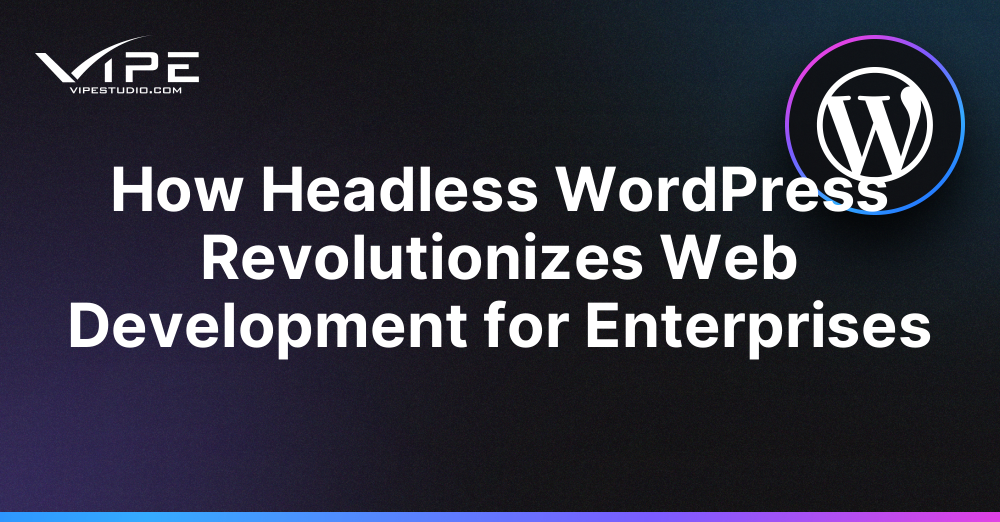08.02.2025
WordPress Development
How Headless WordPress Revolutionizes Web Development for Enterprises
READING TIME: MIN
Table of Content
As businesses continue to adapt to an increasingly digital world, the need for agile, scalable, and customizable web solutions becomes paramount. Headless WordPress, a modern approach to content management, is proving to be a game-changer for enterprise-level websites. This article explores how Headless WordPress empowers enterprises, enhances user experience, and simplifies content management for large-scale digital operations.
What is Headless WordPress?
Headless WordPress is a decoupled version of the popular CMS, where the front-end (the “head”) and back-end (the “body”) are separated. In a traditional WordPress setup, the CMS controls both content management and display. However, in a headless environment, WordPress functions solely as a content management system (CMS), and the front-end presentation is handled by another technology, often using JavaScript frameworks like React or Next.js.
By removing the dependence between content management and presentation, Headless WordPress offers a more flexible and future-proof way to build web applications that are fast, scalable, and platform-agnostic.
Key Benefits of Using Headless WordPress for Enterprises
For enterprises managing complex digital ecosystems, Headless WordPress offers numerous advantages that address both technical and business challenges:
1. Seamless Integration Across Multiple Platforms
With Headless WordPress, enterprises can seamlessly integrate content across multiple channels, including websites, mobile apps, IoT devices, and more. This creates a unified content experience across all platforms, ensuring consistency and accessibility for users no matter the device or medium.
2. Enhanced Performance and Scalability
Headless WordPress empowers enterprises to optimize their front-end performance. By separating the front-end from the back-end, developers can implement modern performance-boosting techniques, such as server-side rendering, static site generation, and content delivery networks (CDNs), ensuring faster load times and a better overall user experience.
Furthermore, the decoupled architecture allows businesses to scale their websites without compromising performance. Whether scaling to millions of users or expanding the number of digital touchpoints, Headless WordPress is designed for flexibility and growth.
3. Flexibility in Front-End Development
One of the biggest advantages of using Headless WordPress is the freedom it offers front-end developers. Since the front-end is decoupled from the back-end, developers can use any technology or framework they prefer, such as React, Vue, Angular, or Next.js. This opens the door to faster development cycles and allows developers to leverage cutting-edge technologies and frameworks to create innovative, dynamic user interfaces.
4. Improved Security and Content Management
In a traditional WordPress setup, vulnerabilities on the front-end can lead to security breaches on the back-end. With Headless WordPress, the front-end is isolated, reducing potential security risks. Additionally, because WordPress is used exclusively for content management, it’s easier to implement robust security protocols that protect your content and data.
Moreover, businesses can manage content in one central hub while delivering it across multiple platforms, making content workflows more streamlined and efficient. Headless WordPress offers content editors a familiar environment, while developers gain the flexibility to build custom front-end solutions.
How to Implement Headless WordPress for Your Enterprise
Implementing Headless WordPress requires a shift in how websites are structured and developed. However, the process can be broken down into manageable steps:
1. Choose the Right Front-End Technology
For enterprises looking to build a headless system, the first step is selecting the appropriate front-end technology. Some of the most popular options include:
- Next.js: A React-based framework that offers server-side rendering (SSR) and static site generation (SSG) for fast, SEO-friendly websites.
- React.js: A JavaScript library for building dynamic user interfaces, ideal for creating engaging single-page applications (SPAs).
- Vue.js: A progressive JavaScript framework that provides a simple, flexible approach to building web interfaces.
These front-end technologies work seamlessly with Headless WordPress to deliver a powerful, flexible web experience.
2. Integrate with APIs
Since Headless WordPress relies on APIs (typically REST or GraphQL) to communicate between the front-end and back-end, the next step is integrating these APIs. WordPress provides built-in REST API support, making it easy to fetch and display content on your front-end. Alternatively, GraphQL offers more flexibility and efficiency for enterprises managing large-scale data.
3. Develop and Deploy
Once the API is set up, developers can build the front-end application using their chosen framework. The front-end communicates with the WordPress back-end to retrieve content, which is then rendered on the website or app. Once the front-end is built, it can be deployed across any platform, ensuring consistency across multiple devices and channels.
4. Ongoing Maintenance and Optimization
After deployment, it’s crucial to monitor and optimize performance. Regular updates, caching strategies, and content delivery networks (CDNs) are essential for maintaining fast load times and optimal user experiences. Additionally, as the business grows and requirements evolve, it’s easy to scale the front-end and back-end independently in a headless setup.
Why Choose Vipe Studio for Your Headless WordPress Solutions?
At Vipe Studio, we specialize in Headless WordPress development, helping enterprises create highly dynamic, scalable, and secure web solutions. Our team of experts ensures seamless integration between WordPress and cutting-edge front-end technologies, delivering robust, performance-driven websites.
If you’re ready to take your enterprise website to the next level with Headless WordPress, contact us today for a tailored solution that meets your unique needs.
Conclusion: Headless WordPress for a Modern Web Development Approach
Headless WordPress represents the future of web development, especially for enterprises seeking flexibility, scalability, and enhanced performance. By decoupling the front-end and back-end, businesses can embrace modern technologies, improve security, and deliver an optimized user experience across multiple platforms. As the digital landscape evolves, Headless WordPress will continue to be an invaluable tool for enterprises aiming to stay ahead of the curve.
More on The Topic
- WordPress Performance Debt Nobody Talks About
- The Admin UX That Shapes Decisions
- Scaling WordPress Without Losing Culture
- WordPress 6.9 “Gene”: What This Release Really Changes
- Managing Gutenberg Chaos at Scale
The content of this website is copyrighted and protected by Creative Commons 4.0.



